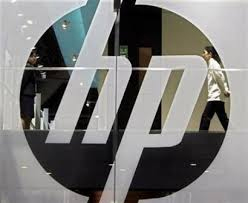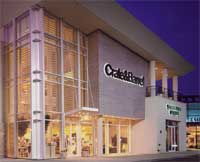 |
February 27, 2014 - Supply Chain Flagship Newsletter |
 |
| THIS WEEK'S SPONSOR: MHI |
 |
|
 |
|
|||||||||||||||||||||||||||||||||||||||||||||||||||||||||||||||||||||||||||||
A Review of Walmart and Amazon 2014
|
||||||||||||||||||||||||||||||||||||||||||||||||||||||||||||||||||||||||||||||
| GILMORE SAYS: |
"In Q4, Amazon's shipping revenue (ad hoc + Amazon Prime service) was $1.37 billion. Shipping costs were $2.34 billion, meaning Amazon had a net loss on shipping of $1.2 billion." WHAT DO YOU SAY? |
That dominance, and the potential fortunes of each in coming years, is not just of interest to the retail sector. Obviously, it matters deeply and directly to consumer goods manufacturers, and indirectly to the preponderance of other types of companies, from packaging suppliers to commodity firms, because in the end most of their demand is ultimately determined by what the consumer buys.
So what is happening here should be of interest to most of us. I am going to take the easy way out this week and look at this in numbers and charts - and the data is fascinating.
In the early to mid-2000s, I was worried Walmart simply could not be stopped, and that the growing share of sales that many/most consumer product companies were experiencing from Walmart was a real issue. It was becoming a Walmart supply chain - and then everything else, which just didn't seem like a good thing to me. Nothing against the Bentonville giant, but who wants to see that level of domination?
I think the jury is still out on that one. As shown in the chart below, sales at Walmart US, Sam's Club and international grew 3.9%, 4.9%, and 7.4%, respectively, in 2013 (Walmart's fiscal 2014). (The chart also shows cumulative average growth over the past 10 years.)
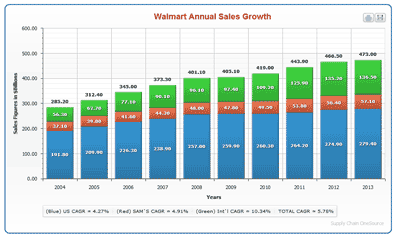
The US sales growth number was above the 3.2% growth in overall US retail sales, excluding autos and parts - but nevertheless we think Walmart lost a bit of market share last year, as explained below
You will find various estimates out there of Walmart's share of US retail sales. For example, if you divide Walmart sales by total retail sales, the number will be relatively low. But if you exclude automobile sales, the number starts to rise.
We like our unique approach, which combines Walmart's US and Sam's sales and compares it to US retail sales (based on Commerce Dept. data) excluding autos and parts, restaurants, gas stations and fuel distributors. Yes, Walmart sells some gasoline and hot dogs too, but not enough to be material, in our view.
As shown in the chart below, Walmart's share of applicable retail sales actually dropped a bit in 2013 to 11.3%, down from 11.5% in 2012, I believe because restaurant sales rose faster than general merchandise retail last year. That 11.3% level is down just under one percentage point from Walmart's highmark of a 12.2% share in 2009.
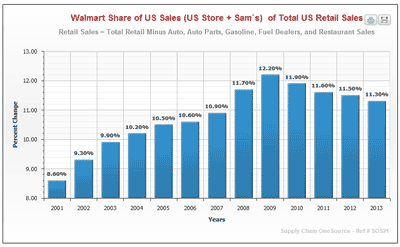
Walmart US same store sales growth was 1.8% last year, up from just .2% in 2012.
One notable piece of data that Walmart does not yet provide is its ecommerce sales - a practice common to many other large US retailers. The logical conclusion is that the numbers from Walmart and others are still very small.
There was a Fortune magazine cover story article more than a decade ago on "The One Company Walmart Fears." Which company was that, in 2003? It was Costco.
Costco is a great company and still a threat to Walmart's dominance, but clearly now the real threat is Amazon - to Walmart and about every other retailer, both here and abroad.
Let's look at Amazon's growth in "merchandise" sales, which excludes media and services sales revenue (the media number I assume includes physical books as well as electronic media, but still think it is best to leave this category out).
Growth is slowing for sure, but still mighty impressive. US merchandise sales growth was 28% in 2013, down from 34.4% in 2012 and 57.4% in 2011, as the law of big numbers takes force (see graphic below).
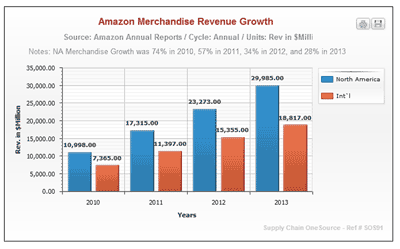
That means, however, that Amazon still represents just 9% of Walmart's US sales (Walmart Stores + Sam's). You'll see reports that indicate a more favorable comparison, but those figures usually include Amazon's international and services sales.
But just about all of that is ecommerce business, and I am sure the Amazon total at this point dwarfs the Walmart online number. The threat, of course, is that Amazon can keep this 20+% type annual growth going - meaning sales would double every 3-4 years. Will Amazon really see that level of growth? That is the $100 billion dollar question.
We've reported on Amazon's rising fulfillment costs a number of times, and will do so again here, but with a slight change from the past. Rather than dividing the reported fulfillment costs against total revenue, we are dividing those cost by just merchandise sales. We'll also note fulfillment costs include inbound logistics costs to get goods to fulfillment centers, but do not include outbound customer shipping costs.
As can be seen below, measured that way, fulfillment costs rose to 17.5% of merchandise sales in 2013, up from 15.7% in 2010. The big driver of those high costs is the continued massive construction of fulfillment centers in the US and around the world.
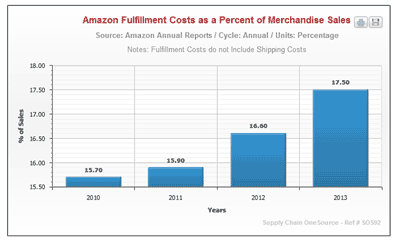
Shipping is a whole other topic. For 2013, Amazon's shipping revenue (ad hoc + Amazon Prime service) was $3.17 billion. Actual shipping costs were $6.63 billion, meaning Amazon had a net loss on shipping of $3.49 billion for the year, representing 4.7% of global sales. Wow - no wonder it appears Amazon may actually increase the price of the Prime service in 2014.
Amazon eked out a $274 million profit for the full year. Gross margins improved from 24.8% in 2012 to 27.3% in 2013 (that's with the shipping hit, which goes into COGS). Inventory turns in Q4 were 8.9, down from 9.2 in 2012. But importantly, on that meager profit, cash flow from operations was up substantially in 2013 to $5.5 billion, up 30% from 2012. That is in large part why Amazon's stock price stays so high with lousy earnings.
I am out of room. Hope you enjoyed this look at our current and emerging retail giant.
What is your reaction to these Walmart and Amazon numbers? Just how big a threat is Amazon? Let us know your thoughts at the Feedback button or section below.
| View Web/Printable Version of this Page |
|
|
|
YOUR FEEDBACK
Continued emails coming in relative to our supply chain guru predictions for 2014, including our Feedback of the Week from Kate Vitasek, one of the creators of the " vested outsourcing" concept for 3PL relationships, who says predictions from Gartner that vested outsourcing won't take off are really quite positive.
We are also publishing a few emails on our expert advice to UPS to avoid a 2014 Christmas delivery fail.
Feedback of the Week: On Vested Outsourcing:
I read your First Thoughts column with great interest. Here's my feedback on the SC predictions (p2) piece: Gartner is projecting an upward trend that could double in a very short time - going from about 10% to about 20% in three years. This may not be viewed as a "take off" - but it is indeed a very solid growth curve. I am also very pleased that Gartner cites the Vested methodology for creating value-based partnerships and it's growing popularity. The University of Tennessee has spent more than a decade studying HOW to get value-based partnerships right and I am excited that Gartner recognizes the value of our methodology. 1) Having the courage to make the physical break from a transactional model to Vested's outcome-based model. Corporate policies and dogma will need to be challenged, and many individuals look at what needs to be done and don't want to challenge existing policies. (For example, a long term agreement that’s maxed at two years with a 30 day term of convenience will not work in Vested and needs to be challenged!) 2) Not having the diligence to follow the Vested Five Rules. Our research clearly shows that what makes Vested so successful is when companies follow ALL Five Rules. Companies that take time to understand the Rules and follow the methodology can and are successful. I often get calls from companies saying "we just selected our supplier and have our contract done. How do we "get Vested"? Think about it: If you already have a contract and you DIDN'T follow the Five Rules you might as well throw it out and start over. (It's like putting your socks on after you’ve put your shoes on!) My biggest piece of advice is use the methodology at the START of the contract process. We offer a great online course called "Creating a Vested Agreement." Buyers and suppliers take the course TOGETHER and step-by-step create their agreement. At the end of the course, they will have constructed an actual contract that follows all Five Rules. Taking the course will ensure that you 1) understand the methodology and 2) follow the Five Rules.
Kate Vitasek | Faculty |
||
| Feedback on Advice to UPS: | ||
Put all the ideas provided by the experts in the article on the table and there will be a UPS (parcel) solution for Xmas 2014. Simply stated, this debacle was the result of the "never ending" discussion of collaboration, lack of, between real partners. I would also add that is a prime example of when the abilities of the virtual world (almost limitless) run smack into the physical world (limitations). The "future drone solution" would not have even solved this one. Gene Nusekabel Columbus, OH
|
||
What planet is Greg Aimi on? To say "This past year in particular, I think, caused a unique challenge in that Christmas was on a Wednesday" Is ludicrous. Christmas falls on a Wednesday once every 7 years, so why is this so unusual? Nick Hutchin
Editor's Note: In fairness to Aimi, I think his reponse would be tha ecommerce volumes were a small fraction seven years ago versus what they were in 2013. His point was just that the timing this year was such that there weekend contributed to the surge of last minute order volumes that had to be delivered in one or two days.
Now should the forecasters have taken that into account? Sure. But it appears they didn't. |
||
I agree with almost everything your experts had to say. It seems so obvious now that UPS should have known a train wreck was coming and then did nothing to stop it.
Jim Tompkins is right - this was a failure of UPS leadership. They could see the Titantic was sinking and stood watching on the decks.
I have to believe UPS and FedEx will implement policies along the lines of what Jerry Hempstead suggests, ideas which etailers may not like but are necessary for the carriers to operate successfully.
Alex Beaucamp Denver
|
SUPPLY CHAIN TRIVIA ANSWER
Q: Gene Gagnon and Eric Baum were the pioneers in what area of distribution management and related technology?
A: Labor Management Systems (LMS) – in the early 1980s. Breakthrough was use of discrete, engineered labor standards.
| © SupplyChainDigest™ 2003-2013. All Rights Reserved. SupplyChainDigest PO Box 714 Springboro, Ohio 45066 |
POWERED BY: XDIMENSION
|








